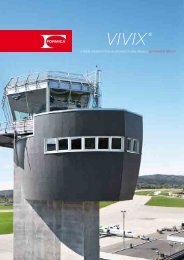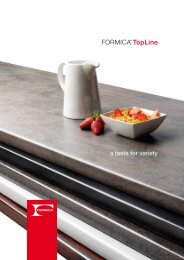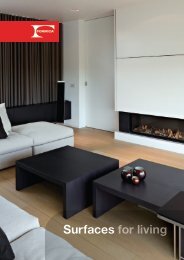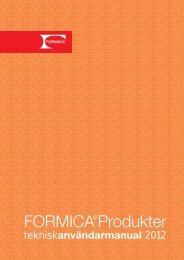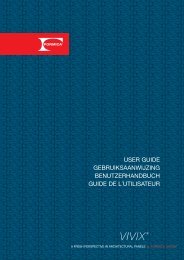Technical Information dispelling traditions - Formica
Technical Information dispelling traditions - Formica
Technical Information dispelling traditions - Formica
Create successful ePaper yourself
Turn your PDF publications into a flip-book with our unique Google optimized e-Paper software.
formica_technical.qxd:formica_technical.qxd 28/11/08 16:01 Page 33<strong>Formica</strong> ® ColorCore 2 of 2Arrises must be trimmed with hand trimmers in the usual manner,with either bevelled or small radius TCT cutters. For best resultshand finishing with a fine file and a cabinet scraper is recommended.Generous bevels and radii up to 2.5 mm may be produced at thearrises, but it should be remembered that such large bevels andradii require more finishing to blend with the surrounding surface.When filing or sanding the edges flush with the substrate, alwayswork towards the substrate to prevent surface chipping. Sandingbelts should be no coarser than 100 grit.When trimming ColorCore down to the surface of normal laminatetake extra care not to expose the brown core of the latter atthe intersection.Special effectsThe solid colour of ColorCore enables a wide variety of decorativeeffects to be achieved by techniques such as multi-layering,engraving, routing and sandblasting, or by combinations ofany of these. The use of hardwood edges in conjunction withColorCore can also create very interesting details.Multi-layeringMulti-coloured sandwiches of ColorCore can be bonded togetherand then sawn at 90° to the glue-line. These laminate strips canthen be used for pre-lipping the edges of table tops, etc. for asolid laminated look.Laminated work of this kind should be bonded with an epoxyadhesive and flat pressed. Prior to bonding, the decorativesurfaces of the inner laminations must be thoroughly sandedto provide a good key for the adhesive.Engraving and routingThe surface of ColorCore may be engraved or routed to amaximum depth of 0.8 mm. Interesting effects may be achievedby this method, ranging from straightforward sign-writing tointricate monochrome patterns and designs.Designs in two or more colours can be achieved by a combination ofmulti-layering and routing. This technique entails bonding one colouron top of another and routing through to reveal the underlyingcolour or colours. Adhesives and bonding procedure should bethe same as for multi-layering.It should be remembered that cutting through the surface willrelease tension to some degree, and it may be necessary tomachine the reverse side to maintain panel stability andprevent bowing.A slight colour change may be noticeable in the machined areasdue to differences in gloss levels, particularly with dark colours.This difference in appearance can be minimised on narrowengraved lines by the application of a light silicone-free oil.Alternatively, large routed areas may be scraped and polishedusing progressively finer grades of glass paper, and a finalbuffing with T-Cut or Brasso.SandblastingSandblasting is another technique that can be used to createinteresting decorative effects with ColorCore, with surface texturingranging from subtle changes in gloss level to deep sculpturing to amaximum depth of 0.8 mm.Fabrication guidelinesIn order to produce a tight joint allow up to 6 mm overhang whenapplying the first piece of ColorCore to the edge of the substrate,for subsequent machining flush with the surface.To avoid chipping, use sharp tools to machine ColorCore flush withthe substrate. When sanding always work towards the substrate,using a fine grit sanding belt. Take care not to round-over the edgeas this will result in a wide glue-line.Apply the surface laminate with a thin (but sufficient) even coatingof adhesive, again allowing a slight overhang. Use appropriatebonding pressure to achieve a tight glue-line.Machine the finished edge of the surface laminate with a bevel orradius cutter, and file or scrape smooth.<strong>Formica</strong> Limited, Coast Road, North Shields, Tyne & Wear NE29 8RE. Tel: 0191 259 3000. Fax: 0191 258 2719.<strong>Formica</strong> is a registered trade mark of <strong>Formica</strong> Corporation or its subsidiaries.<strong>Technical</strong> Services Department April 2004.32




